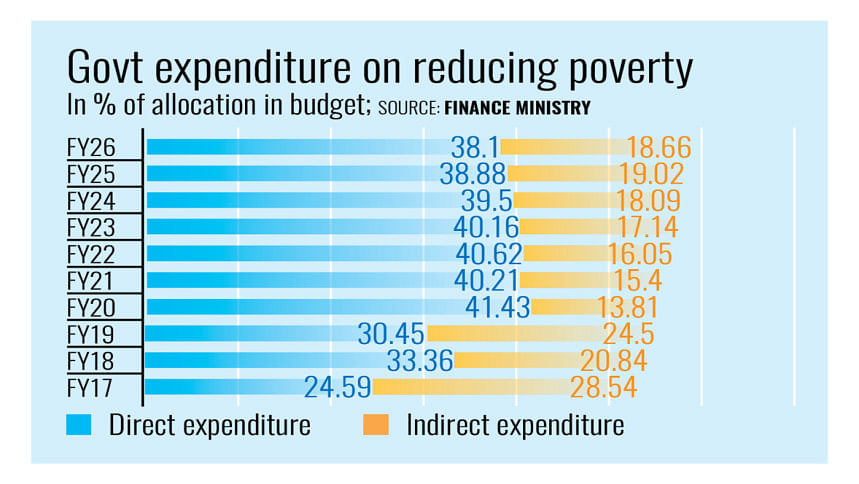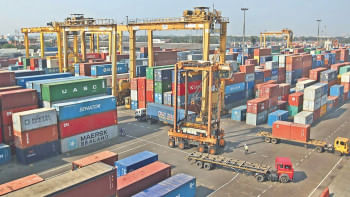Allocation for poverty reduction drops to 4-year low in FY26

Bangladesh's expenditure on poverty reduction has been gradually declining, and in the upcoming fiscal year of 2025-26, it is set to hit a four-year low due to a decrease in spending that directly impacts hunger.
Figures from the finance ministry show that poverty-reducing expenditure has dropped to 56.77 percent in the Tk 790,000 crore national budget for FY26, down from 57.9 percent of the total outlay in the outgoing fiscal year.
One reason is the continued reduction in expenses that directly affect poverty.
In the proposed budget, the share of direct expenditure is projected at 38.1 percent — the lowest in seven years. However, analysts have questioned the methodology used to assess how these expenditures impact poverty.
The finance ministry has not provided details beyond ministry-wise data on direct and indirect poverty-reducing expenditure against budget allocations.
According to the ministry, 98 percent of the food ministry's allocation is considered poverty-reducing, with 94.5 percent directly contributing to poverty reduction.
Similarly, 94 percent of the Bridges Division's budget and 90 percent of that of the Statistics and Informatics Division are directed toward poverty alleviation.
Over 80 percent of the allocations for the ministries of disaster management, railways, primary and mass education, agriculture, and road transport also contribute to reducing poverty.
Analysts said some expenditures impact poverty, while some are targeted expenditures for poverty alleviation. From this perspective, spending on sectors such as health and education helps cut poverty.
But targeted expenditure for measures such as subsidised food distribution under social protection schemes and job creation for the poor impacts poverty directly.
Selim Jahan, former director of the UNDP's Human Development Report Office, said poverty-reducing expenditure has consistently declined as a share of GDP — always under one-tenth and now below 0.8 percent.
He noted that two-thirds of it were operating costs, and only one-third was for development.
Fahmida Khatun, executive director of the Centre for Policy Dialogue (CPD), raised a similar concern, pointing out that the ADP's share of GDP has fallen in the revised FY25 budget.
"This is worrying, because the poor are struggling to survive due to prolonged high inflation and lack of employment opportunities," she said.
"The government needs to enhance its allocation for the poor, particularly through allocations which are direct and have an immediate impact," she said.
Currently, 18.7 percent of Bangladesh's population lives in poverty, with 5.6 percent in extreme poverty. This could worsen due to inflation, political uncertainty, weak investment, and low industrial growth.
The World Bank's Poverty and Equity Briefs for April warned that extreme poverty might rise to 9.3 percent, adding 30 lakh more to the poor.
"Inequality is also expected to widen, with the Gini index increasing by one point, potentially affecting the nation's ability to achieve middle-income status by 2026," the WB noted.
Selim Raihan, executive director of the South Asian Network on Economic Modeling (SANEM), said two aspects must be reviewed for budgetary spending to truly reduce poverty — investment and social protection.
"Investment is essential for job creation, improved earnings, and sustainable income growth — key elements in lifting people out of poverty," he said.
"In Bangladesh, concerns are growing over sluggish investment trends and limited employment opportunities, which undermine the potential of the budget to drive inclusive growth," he added.
Raihan, a professor of economics at the University of Dhaka, also stressed improving social protection.
"While social safety nets are included under poverty-related spending, Bangladesh continues to face serious issues such as insufficient funding, poor targeting, leakages, and corruption," he said.
"These problems hinder the ability of social protection initiatives to reach and support the poor meaningfully," he said.
All three economists questioned the finance ministry's poverty-reducing expenditure data.
Raihan said the numbers lack credibility without a clear methodology. Simply labelling budget parts as "poverty-reducing" doesn't ensure impact.
Jahan agreed. "Poverty-reducing expenditure is misleading," he said.
He distinguished between poverty-reducing and direct poverty expenditures — the latter being targeted.
"Poverty-reducing expenditure is an umbrella term. It implicitly assumes that expenditures under this head would directly or indirectly impact poverty reduction, which may be true or not true," he said.
"Therefore, poverty-reducing expenditures in reality may have insignificant effects on poverty reduction," he added.
Jahan said what matters is the money spent directly on poverty reduction.
In FY26, Tk 3,707 crore will be given under 39 social safety net programmes, which would directly impact poverty.
"There is little attention to link direct poverty reduction programmes to employment generation, which may serve the dual purpose of poverty reduction and job creation," he said.
Fahmida added that the finance ministry's figures lacked clarity.
"Expenditures of some ministries, such as the Ministry of Disaster Management and Relief or the Ministry of Food, are well understood," she said.
"But for most other ministries, it is difficult to decipher any message from the figures and any attempt to do so could be misleading," she added.
"For example, roads, bridges, health services etc are used by both poor and non-poor. How the allocation is divided between the poor and non-poor, how this is categorised as poverty-reducing expenditure, and how they are actually spent should be transparent," she explained.

 For all latest news, follow The Daily Star's Google News channel.
For all latest news, follow The Daily Star's Google News channel. 



Comments